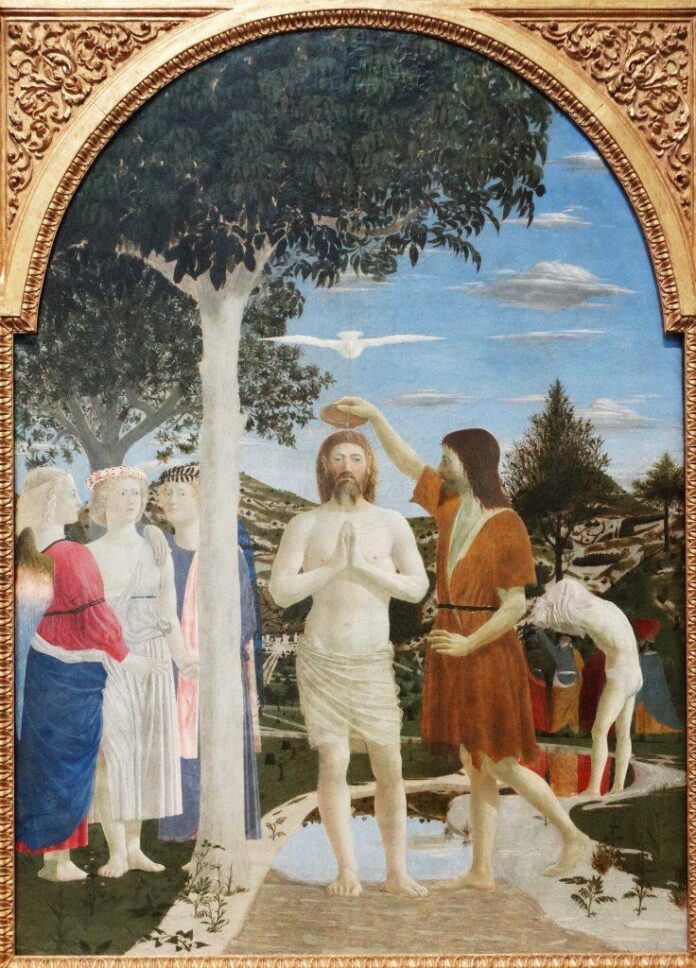Talk of UFOs—sorry, “unidentified aerial phenomena”—spilled into yet another U.S. congressional hearing in July. The session followed a run of announcements and studies by the likes of NASA and the RAND Corporation regarding UAP sightings, turning what once was a fringe science and conspiracy theory into a matter of national interest and security.
This new spate of interest in extraterrestrials is but the latest chapter in ufology, a field with roots in the late 19th century. But if certain E.T. proponents are to be believed, this fascination with the existence of aliens stretches back further in history. Their evidence? Cave paintings, Nazca lines, prehistoric sculptures, and—for our purposes—art-historical paintings.
That some old masters depicted encounters with the third kind might be plainly in view for anyone looking closely (very closely) to a few of their works. Squint or stare and you might spot curious aerial phenomena, bizarre beings, or other unexplainable artifacts. Are they signs of an extraterrestrial presence or merely symbols of religious rapture? Is there a difference? Who knows?
Below, we’ve arrayed seven of these historical artworks that contain unidentified objects, so you can make like Congress and be the judge.
Masolino da Panicale
The Miracle of the Snow (c. 1428–32)

Masolino da Panicale, (c. 1428–32). Photo: Mondadori Portfolio / Getty Images.
The Florentine painter created this altarpiece to commemorate the founding of Roman basilica Santa Maria Maggiore. Legend has it that the church’s site was chosen by the Virgin Mary herself, who caused snow to fall on that exact spot on the Esquiline Hill in the summer of 352—a scene rendered in Da Panicale’s panel. To some eyes, however, Da Panicale’s depiction of lenticular clouds looks akin to a fleet of alien spaceships, overseen by Jesus and Mary. Could the so-called miracle of the snow be an allegory for an invasion of flying saucers? It’s worth noting that even in the colder seasons, snow is rare in Rome. But then again, so are UFOs… presumably.
Jacques Legrand
Livre des Bonnes Meurs (c. 1430)

Jacques Legrand, (c. 1430), folio 129v. Photo: Musée Condé, Chantilly.
Contemporary interest in the pages of the illuminated manuscript has less to do with its content, which teaches good manners to folks from clerics to commoners, but a striking image on folio 129 verso. In rich tones, it depicts the goddess of luck Fortuna beside her wheel, surrounded by a group of male petitioners, with a decorated gold sphere hovering bizarrely in the sky above them. Could it be the sun, a hot-air balloon, or another representation of the wheel of fortune? No one has figured it out, but you bet the ufologists have.
Domenico Ghirlandaio
The Madonna with Saint Giovannino (c. 15th century)

Domenico Ghirlandaio, (c. 15th century). Photo: Wikimedia Commons.
The reputation of this 15th-century painting, installed at the Palazzo Vecchio, is such that it is colloquially referred to as “Madonna dell’UFO.” While portraying the Madonna with the infant Jesus and Saint John, Ghirlandaio (the work has also been attributed to Jacopo del Sellaio and Sebastiano Mainardi) chose to paint an odd blob in the sky to the right of Mary’s shoulder, with the figures of a man and a dog looking on. There’s even speculation that Mary has positioned herself to shield the children, who, it seems, might not be the only celestial beings in frame.
Michael Pacher
Saint Augustine and the Devil (c. 1475)

Michael Pacher, (c. 1475). Photo: DeAgostini / Getty Images.
Pacher’s oil illustrates a simple legend: the devil showing Augustine his entry in the book of vices (the saint only has the one recorded sin of not praying hard enough, of course). Or does it? Depending on who’s viewing it, the Gothic painter’s grotesque demon, complete with green skin and red eyes on its rear-end, is less mythical and more extraterrestrial. Which turns the painting’s depiction into less a meeting of good and evil, and more artistic proof that we’re not alone.
Carlo Crivelli
The Annunciation with Saint Emidius (1486)

Carlo Crivelli, (1486). Photo: VCG Wilson/Corbis via Getty Images.
Crivelli’s luxuriously detailed work offers his artistic interpretation of the annunciation, the archangel Gabriel’s announcement to Mary that she will soon bear the Christian messiah. Except that Mary looks to be receiving the announcement from an extraterrestrial vehicle, its message beaming down laser-like to reach her. It’s the kind of light, so say proponents, consistent with those reported in modern-day alien abductions, presenting fodder for the theory that Mary was, well, abducted and artificially inseminated by aliens.
Hans Glaser
Celestial Phenomenon Over Nuremburg (1561)

Hans Glaser, broadsheet with woodcut (1561). Photo: Wikimedia Commons.
In 1561, Glaser, a Nuremberg artist and publisher, produced a broadsheet to report on a “dreadful apparition” that occurred just above the city on April 14. Accompanying his account of an aerial battle between objects shaped like globes and crosses was his illustrative, almost buoyant woodcut depicting the multi-colored UAPs (to those of you who are new to ufology, that is short for unidentified anomalous phenomena) swirling across the sun. While skeptics today reckon the phenomenon was down to parhelia, an atmospheric optical occurrence, or perhaps an early use of fireworks, Glaser deemed it—what else?—a “high sign” from God.
Aert de Gelder
Baptism of Christ (c. 1710)

Aert de Gelder, (c. 1710). Photo: The Fitzwilliam Museum.
De Gelder was one of Rembrandt’s last pupils and his paintings of Biblical scenes bear the Dutch Master’s heightened emotionalism. His circa 1710 work captures the baptism of Jesus by John the Baptist at the River of Jordan, spotlit by beams from a huge disc in the sky. It’s ostensibly a representation of “the Spirit of God descending like a dove and alighting on [Jesus],” according to Matthew 3:16. Or could it be de Gelder was trying to tell us something about the audience at Jesus’s baptism?
More Trending Stories:

























